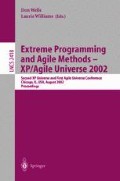Abstract
This paper reports the results of an analysis of thirty-one extreme programming (XP)/agile methods early adopter projects completed by fourteen firms who have embraced the techniques in the form of lessons learned. The survey results show that early adopters have cut costs, improved productivity and reduced time to market through the use of these methods. To get the most from these methods, fifteen lessons learned have been developed that build on the experiences of others. Several of these lessons run counter to the teachings of the methodology developers. The paper next provides a scorecard that rates XP’s performance in eight application domains. The paper concludes by summarizing four critical success factors for early adopters.
Access this chapter
Tax calculation will be finalised at checkout
Purchases are for personal use only
Preview
Unable to display preview. Download preview PDF.
References
Fowler, Martin: Refactoring: Improving the Design of Existing Code, Addison-Wesley, New York (1999).
Reifer, Donald J.: How Good Are Agile Methods? Software, IEEE, New York, Issue 4(2002).
Beck, Kent: Extreme Programming Explained, Addison-Wesley, New York (2000).
Auer, Ken and Miller, Roy: Extreme Programming Applied, Addison-Wesley, New York (2002).
Wake, William C.: Extreme Programming Explored, Addison-Wesley, New York (2002).
Highsmith, Jim: Does Agility Work? Software Development magazine, San Francisco, CA, Vol. 10, No. 6, (2002) 30–36.
Rising, Linda, Agile Meetings, The Software Testing & Quality Engineering (STQE) magazine, Orange Park, FL, Vol. 4, Issue 3, (2002) 42–46.
Paulk, Mark C., Weber, Charles V., Curtis, Bill and Chrissis, Mary Beth: The Capability Maturity Model: Guidelines for Improving the Software Process, Addison-Wesley, New York (1995).
Reifer, Donald J.: Making the Software Business Case: Improvement by the Numbers, Addison-Wesley, New York (2001).
Kruchten, Philippe: The Rational Unified Process: An Introduction, Addison-Wesley, New York (1998).
Barry_W. Boehm, Chris Abts, A. Winsor Brown, Sunita Chulani, Bradford K. Clark, Ellis Horowitz, Ray Madachy, Donald Reifer, Bert Steece: Software Cost Estimation with COCOMO II, Prentice Hall, New York, (2000) 31–33.
Highsmith, James A. III: Adaptive Software Development: A Collaborative Approach to Managing Complex Systems, Dorset House Publishing, New York (2000).
Williams, Laurie: Extreme Programming (and Pair Programming, In: Proceedings of the University of Southern California-Center for Software Engineering Annual Research Review, Los Angeles, CA, (2002)
Constantine, Larry L: The Peopleware Papers, Yourdon Press, New York (2001) (see thoughts on consensus building on 13–16).
Rakitin, Steven R.: Manifesto Elicits Cynicism, Letter to the Editor, Computer, IEEE, New York, Issue 12 (2001) 4.
Paulk, Mark C.: Extreme Programming from a CMM Perspective, Software, IEEE, New York, Issue 6 (2001) 19–26.
Cusumano, Michael A. and Selby, Richard W.: Microsoft Secrets, Simon & Schuster: A Touchstone Book, New York (1998). (See notes on builds on pp. 263–271).
Kerth, Norman L.: Project Retrospectives: A Handbook for Team Reviews, Dorset House Publishing, New York (2001).
Boehm, Barry: Private Communications (2002).
Cockburn, Alistair: Agile Software Development, Addison-Wesley, New York (2002).
Author information
Authors and Affiliations
Editor information
Editors and Affiliations
Rights and permissions
Copyright information
© 2002 Springer-Verlag Berlin Heidelberg
About this paper
Cite this paper
Reifer, D.J. (2002). How to Get the Most out of Extreme Programming/Agile Methods. In: Wells, D., Williams, L. (eds) Extreme Programming and Agile Methods — XP/Agile Universe 2002. XP/Agile Universe 2002. Lecture Notes in Computer Science, vol 2418. Springer, Berlin, Heidelberg. https://doi.org/10.1007/3-540-45672-4_18
Download citation
DOI: https://doi.org/10.1007/3-540-45672-4_18
Published:
Publisher Name: Springer, Berlin, Heidelberg
Print ISBN: 978-3-540-44024-6
Online ISBN: 978-3-540-45672-8
eBook Packages: Springer Book Archive

